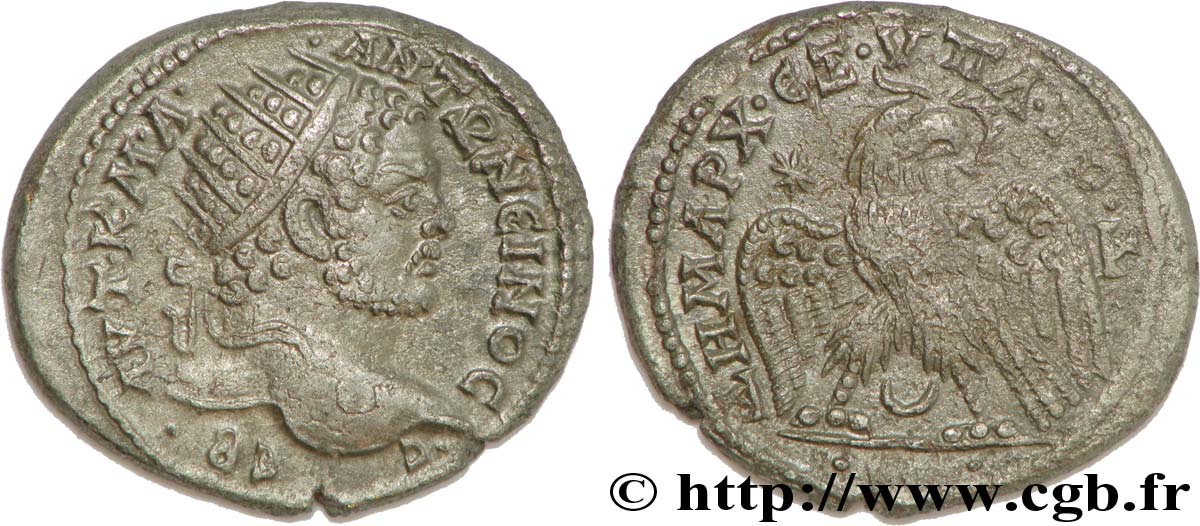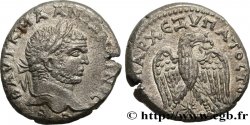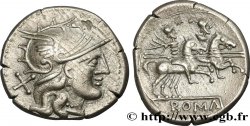bpv_158447 - CARACALLA Tétradrachme syro-phénicien
Not available.
Item sold on our e-shop
Price : 130.00 €
Item sold on our e-shop
Price : 130.00 €
Type : Tétradrachme syro-phénicien
Date: 215-217
Mint name / Town : Carrhae, Mésopotamie
Metal : billon
Diameter : 25,5 mm
Orientation dies : 12 h.
Weight : 12,07 g.
Coments on the condition:
Flan large et oblong, belles frappe et surfaces, minimes traces d’usure
Catalogue references :
Obverse
Obverse description : Tête radiée de Caracalla à droite, vu de trois-quarts en arrière, un ruban de la couronne radiée descendant sur l’épaule (O*01).
Obverse legend : AUT K. M. A.- .ANTWNEINOS .S-EB (Autokrator Kaisar Markos Aurhlios Antwneinos Sebastos)
Obverse translation : (L’empereur césar Marc Aurèle Antonin auguste).
Reverse
Reverse description : Aigle debout à gauche, les ailes déployées, la tête et la queue tournées à droite, tenant dans son bec une couronne feuillée ; une étoile flamboyante dans le champ à gauche de la tête de l’aigle ; un croissant pointe en l’air entre les pattes, deux points à l’exergue.
Reverse legend : DHMARC. EX. UPATO. D., (Dhmarcikhs Ex Ousias Upatos D)
Reverse translation : (Revêtu de la puissance tribunitienne consul pour la quatrième fois).
Commentary
Les émissions de Carrhae (également appelée Harran, d’un mot akkadien signifiant croisement, certainement de routes), sont importantes. La ville étant directement sur la ligne de front, le trésor militaire y avait besoin de fonds pour les troupes et la logistique.
Le plus intéressant de ces émissions est l’existence, tant pour Caracalla que pour Macrin, de deux séries distinctes dont l’interprétation est plus qu’intéressante car elle semble montrer que la ville était, de fait, dirigée et administrée par ses cultes principaux.
Les maigres renseignements disponibles indiquent un culte de Lunus, dieu mantique de la Lune mâle, qu’allait interroger Caracalla lorsqu’il fut assassiné. Les anciens suggèrent d’ailleurs que c’est la crainte de Macrin de voir ses complots dévoilés par le dieu qui précipitèrent le meurtre. Ce dieu, de son nom sémitique Sin, avait un temple de la plus haute antiquité dans la ville. Son nom est mentionné entre autres dans des traités de paix entre Mésopotamiens. Il fut pillé en 609 et restauré à trois reprises par les rois Salmanasar III, Assurbanipal et Nabonide et ne fut définitivement détruit qu’en 382 sur ordre de Théodose.
L’examen des symboles fait apparaître d’une part un bucrane de face entouré de deux points (ces deux points ne sont pas décoratifs, ils représentent deux étoiles, certainement celles du soir et du matin), d’autre part un croissant pointes en haut avec deux ou trois points en exergue, un astre rayonnant au-dessus de l’aile gauche de l’aigle.
Systématiquement, les frappes au bucrane sont liées à des effigies de l’empereur laurées alors que celles au croissant sont liées à des effigies radiées. C’est un cas où, Indiscutablement, lauré ou radié a un sens que l’on ne peut attribuer à une fantaisie du graveur car l’examen des deux séries montre bien que le même graveur a réalisé les deux.
On peut supposer, du peu que l’on sait des cultes locaux, que les séries au bucrane relèvent du culte de Malakbel, dont le symbole était un taureau et qui gouvernait les étoiles du soir et du matin.
La série au croissant serait celle de Lunus, ou Sin, qui est souvent représenté sur les bronzes avec un croissant de lune pointes en haut. Il serait lui aussi lié aux étoiles du soir et du matin mais aussi à un astre rayonnant (le Soleil ? Ceci pourrait expliquer, dans un système hiérogamique, le choix de la couronne radiée pour l’avers).
La seule chose dont nous sommes certains est que nous sommes en présence de deux cultes différents mais liés.
Si nous considérons comme valide l’hypothèse de la frappe de ces tétradrachmes de 215 / 217 comme une taxe au profit du trésor militaire, nous pouvons en déduire que les deux pouvoirs financiers de la ville étaient ces deux cultes, donc que la ville était administrée par des clergés.
Pour une intéressante histoire de la ville au travers des millénaires (Abraham y vécut !) voir http://www.livius.org/ha-hd/harran/harran.html .
On note que les sigma sont gravés en C.
Dans la base TSP maintenue par Michel Prieur, soixante-quatorze exemplaires sont maintenant répertoriés. Notre exemplaire, qui provient de la trouvaille de Julia, est le 0830_046.
The emissions from Carrhae (also called Harran, from an Akkadian word meaning crossing, certainly of roads), are important. Since the city was directly on the front line, the military treasury needed funds for troops and logistics..
The most interesting of these emissions is the existence, for both Caracalla and Macrinus, of two distinct series whose interpretation is more than interesting because it seems to show that the city was, in fact, directed and administered by its main cults..
The scant information available indicates a cult of Lunus, the mantic god of the male Moon, whom Caracalla was about to interrogate when he was assassinated.. The ancients suggest, moreover, that it was Macrinus' fear of having his plots revealed by the god that precipitated the murder.. This god, whose Semitic name was Sin, had a temple of the highest antiquity in the city. His name is mentioned among other things in peace treaties between Mesopotamians. It was plundered in 609 and restored three times by kings Shalmaneser III, Ashurbanipal and Nabonidus and was not finally destroyed until 382 on the orders of Theodosius.
Examination of the symbols reveals on the one hand a bucranium facing on, surrounded by two points (these two points are not decorative, they represent two stars, certainly the evening and morning stars), on the other hand a crescent with points upwards with two or three points in exergue, a radiant star above the left wing of the eagle.
Systematically, the bucranium strikes are linked to laureate effigies of the emperor while those with the crescent are linked to radiate effigies.. This is a case where, indisputably, laureate or radiate has a meaning that cannot be attributed to the engraver's whim because the examination of the two series clearly shows that the same engraver produced both..
From the little that is known about local cults, it can be assumed that the bucranium series belong to the cult of Malakbel, whose symbol was a bull and who governed the evening and morning stars..
The crescent series would be that of Lunus, or Sin, who is often represented on bronzes with a crescent moon with its points upwards. It would also be linked to the evening and morning stars but also to a radiant star (the Sun? This could explain, in a hierogamic system, the choice of the radiated crown for the obverse).
The only thing we are certain of is that we are in the presence of two different but linked cults..
If we consider as valid the hypothesis of the minting of these tetradrachms of 215 / 217 as a tax for the benefit of the military treasury, we can deduce that the two financial powers of the city were these two cults, therefore that the city was administered by clergy.
For an interesting history of the city through the millennia (Abraham lived there!) see http://www. Livius. org/ha-hd/harran/harran. html .
Note that the sigmas are engraved in C.
In the TSP database maintained by Michel Prieur, seventy-four examples are now listed. Our example, which comes from Julia's find, is 0830_046
Le plus intéressant de ces émissions est l’existence, tant pour Caracalla que pour Macrin, de deux séries distinctes dont l’interprétation est plus qu’intéressante car elle semble montrer que la ville était, de fait, dirigée et administrée par ses cultes principaux.
Les maigres renseignements disponibles indiquent un culte de Lunus, dieu mantique de la Lune mâle, qu’allait interroger Caracalla lorsqu’il fut assassiné. Les anciens suggèrent d’ailleurs que c’est la crainte de Macrin de voir ses complots dévoilés par le dieu qui précipitèrent le meurtre. Ce dieu, de son nom sémitique Sin, avait un temple de la plus haute antiquité dans la ville. Son nom est mentionné entre autres dans des traités de paix entre Mésopotamiens. Il fut pillé en 609 et restauré à trois reprises par les rois Salmanasar III, Assurbanipal et Nabonide et ne fut définitivement détruit qu’en 382 sur ordre de Théodose.
L’examen des symboles fait apparaître d’une part un bucrane de face entouré de deux points (ces deux points ne sont pas décoratifs, ils représentent deux étoiles, certainement celles du soir et du matin), d’autre part un croissant pointes en haut avec deux ou trois points en exergue, un astre rayonnant au-dessus de l’aile gauche de l’aigle.
Systématiquement, les frappes au bucrane sont liées à des effigies de l’empereur laurées alors que celles au croissant sont liées à des effigies radiées. C’est un cas où, Indiscutablement, lauré ou radié a un sens que l’on ne peut attribuer à une fantaisie du graveur car l’examen des deux séries montre bien que le même graveur a réalisé les deux.
On peut supposer, du peu que l’on sait des cultes locaux, que les séries au bucrane relèvent du culte de Malakbel, dont le symbole était un taureau et qui gouvernait les étoiles du soir et du matin.
La série au croissant serait celle de Lunus, ou Sin, qui est souvent représenté sur les bronzes avec un croissant de lune pointes en haut. Il serait lui aussi lié aux étoiles du soir et du matin mais aussi à un astre rayonnant (le Soleil ? Ceci pourrait expliquer, dans un système hiérogamique, le choix de la couronne radiée pour l’avers).
La seule chose dont nous sommes certains est que nous sommes en présence de deux cultes différents mais liés.
Si nous considérons comme valide l’hypothèse de la frappe de ces tétradrachmes de 215 / 217 comme une taxe au profit du trésor militaire, nous pouvons en déduire que les deux pouvoirs financiers de la ville étaient ces deux cultes, donc que la ville était administrée par des clergés.
Pour une intéressante histoire de la ville au travers des millénaires (Abraham y vécut !) voir http://www.livius.org/ha-hd/harran/harran.html .
On note que les sigma sont gravés en C.
Dans la base TSP maintenue par Michel Prieur, soixante-quatorze exemplaires sont maintenant répertoriés. Notre exemplaire, qui provient de la trouvaille de Julia, est le 0830_046.
The emissions from Carrhae (also called Harran, from an Akkadian word meaning crossing, certainly of roads), are important. Since the city was directly on the front line, the military treasury needed funds for troops and logistics..
The most interesting of these emissions is the existence, for both Caracalla and Macrinus, of two distinct series whose interpretation is more than interesting because it seems to show that the city was, in fact, directed and administered by its main cults..
The scant information available indicates a cult of Lunus, the mantic god of the male Moon, whom Caracalla was about to interrogate when he was assassinated.. The ancients suggest, moreover, that it was Macrinus' fear of having his plots revealed by the god that precipitated the murder.. This god, whose Semitic name was Sin, had a temple of the highest antiquity in the city. His name is mentioned among other things in peace treaties between Mesopotamians. It was plundered in 609 and restored three times by kings Shalmaneser III, Ashurbanipal and Nabonidus and was not finally destroyed until 382 on the orders of Theodosius.
Examination of the symbols reveals on the one hand a bucranium facing on, surrounded by two points (these two points are not decorative, they represent two stars, certainly the evening and morning stars), on the other hand a crescent with points upwards with two or three points in exergue, a radiant star above the left wing of the eagle.
Systematically, the bucranium strikes are linked to laureate effigies of the emperor while those with the crescent are linked to radiate effigies.. This is a case where, indisputably, laureate or radiate has a meaning that cannot be attributed to the engraver's whim because the examination of the two series clearly shows that the same engraver produced both..
From the little that is known about local cults, it can be assumed that the bucranium series belong to the cult of Malakbel, whose symbol was a bull and who governed the evening and morning stars..
The crescent series would be that of Lunus, or Sin, who is often represented on bronzes with a crescent moon with its points upwards. It would also be linked to the evening and morning stars but also to a radiant star (the Sun? This could explain, in a hierogamic system, the choice of the radiated crown for the obverse).
The only thing we are certain of is that we are in the presence of two different but linked cults..
If we consider as valid the hypothesis of the minting of these tetradrachms of 215 / 217 as a tax for the benefit of the military treasury, we can deduce that the two financial powers of the city were these two cults, therefore that the city was administered by clergy.
For an interesting history of the city through the millennia (Abraham lived there!) see http://www. Livius. org/ha-hd/harran/harran. html .
Note that the sigmas are engraved in C.
In the TSP database maintained by Michel Prieur, seventy-four examples are now listed. Our example, which comes from Julia's find, is 0830_046








 Report a mistake
Report a mistake Print the page
Print the page Share my selection
Share my selection Ask a question
Ask a question Consign / sell
Consign / sell
 Full data
Full data














